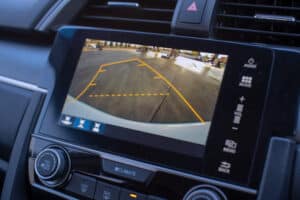Backup Camera System
Since May 2018, the federal law requires that all new vehicles, including passenger cars, trucks and vans, weighing less 10,000 pounds, be equipped with rearview monitor technology. In most cases, this means rear-mounted cameras.
Most backup camera systems have on-screen guides: two parallel lines to help you navigate into or out from parking spaces. Some systems also include a middle line to help keep your vehicle in the center of the parking space. Modern color displays enable the system to change from green to red when you are getting closer to an obstacle. This, in combination with an audible alert from the rear-facing sensor, can help prevent accidents when backing up.

Car rear view system monitor reverse video camera.
The idea behind any backup camera system seems simple at first. A camera at the back of the vehicle turns on when it is in reverse and displays an image on a monitor. The reality, however, is more complex. A backup camera system, even at its most basic level, is a sophisticated piece of tech, and it gets more advanced all the time.
The image captured by the camera is where they start to become more complex. A backup camera system does not transmit a normal image, but rather a mirror-image to the monitor. This ensures that the driver can see the image in the correct orientation. The image would be inverted if it was a direct feed. The system will correct it so that the display is logical.
We are a leading supplier of precision lenses to OEM backup camera systems. You can count on us for the exact lens you need for your design. With each new camera generation, manufacturers demand improvements in terms of technical and commercial aspects. We will continue to expand our product offering with more cost-effective and better performing solutions. Wide-angle lenses are available for automotive image sensors.
In general, manufacturers install the backup camera in the rear trim pieces of their vehicles. These cameras are not very noticeable, but can be hidden in the bumper or near the license plate. They may also be in the trunk lid, or the tailgate on an SUV or pickup. They are usually angled downward to give the best view behind the vehicle. The image is wider than a rear-view-mirror because it uses wide-angle lenses.
The technology is constantly evolving. In many ways the future has already arrived. Many automakers, for example, offer 360-degree cameras, also known as bird’s eye view systems. This type of system uses four exterior cameras to produce an accurate overhead image that can be helpful when maneuvering around tight spaces. This technology is often available as an optional feature or part of a package.
Cameras will increasingly be integrated with sensors and computer systems in active systems as autonomous vehicles become more advanced. These cameras will help cars navigate, stay oriented in lanes, keep a safe distance from other cars and objects, read road signage, avoid accidents and adjust their controls according to the weather or traffic conditions. These functions are already available as adaptive cruise controls, adaptive headlights, and lane-keeping systems. But autonomous vehicles will combine these technologies and more into a self-driving vehicle.




